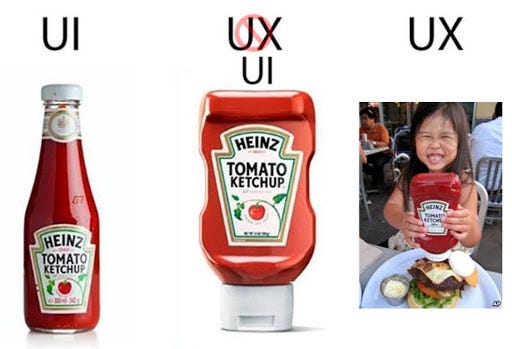ux和ui
At face value, this meme appears to be a quick and easy tool for educating the general public about what the differences are between UI and UX. You might look at the attractive glass bottle labeled “UI” and understand that UI might have to do more with aesthetics. The less attractive but easier to use plastic bottle labeled “UX” is meant to be stored upside down, making it easier for the user to squirt out ketchup, rather than having to smack the bottom of the glass version. This gives the average person the impression that UX might be more about the actual functionality of a product.
從表面上看,這個模因似乎是一種快速簡便的工具,用于向公眾宣傳UI和UX之間的區別。 您可能會看到標有“ UI”的有吸引力的玻璃瓶,并了解UI可能在美學方面需要做更多的事情。 吸引力較小但更易于使用的標有“ UX”的塑料瓶可以倒置存放,從而使用戶更容易噴出番茄醬,而不必打玻璃杯的底部。 這給普通人一個印象,即UX可能更多地與產品的實際功能有關。
The most obvious issue with this meme is that it boils down an entire field of study down to a simple image. UX and UI are complex and multifaceted, with a lot more nuance than this image suggests.
這個模因最明顯的問題是它將整個研究領域簡化為一個簡單的圖像。 UX和UI復雜且多面,比此圖像所暗示的要細膩得多。
If we then start to look into the history of Heinz ketchup and their packaging design, we can start to see how the UX vs. UI meme starts to fall apart even more.
然后,如果我們開始研究亨氏番茄醬及其包裝設計的歷史,就可以開始了解UX vs. UI模因是如何崩潰的。
亨氏包裝設計簡史 (A brief history of Heinz packaging design)
The glass bottle labeled “UI” was created at a much earlier point in history than the upside-down ketchup bottle. As Heinz has grown and developed as a company over the years, so too has its packaging design and the ketchup product itself.
標有“ UI”的玻璃瓶創建于歷史上比倒置的番茄醬瓶要早得多。 隨著亨氏作為一家公司的發展壯大,其包裝設計和番茄醬產品本身也是如此。
In 1890, the first iconic Heinz glass ketchup bottle was designed and released to the public. The most innovative thing about the attractive glass container was that it allowed consumers to see through the packaging and look at the product inside.
1890年,設計了第一個標志性的亨氏玻璃番茄醬瓶,并向公眾發布。 吸引人的玻璃容器最具創新性的一點是,它使消費者可以透視包裝并查看內部產品。
Over the next century, the ketchup bottle went through several rounds of innovation. In 1970, Heinz created a 32-ounce ketchup bottle which contained much more product than its predecessors.
在下一世紀,番茄醬瓶經歷了幾輪創新。 1970年,亨氏(Heinz)創建了一個32盎司的番茄醬瓶,其中的產品比以前的產品多得多。

The first squeeze tube from Heinz came out in 1983 when the company created a funny green ketchup marketed towards kids.
1983年,亨氏推出了第一支擠壓管,當時該公司制造了一種面向兒童的有趣的綠色番茄醬。

It was the popularity of this easy-to-use packaging that lead Heinz to create the upside-down, plastic, easy-squeeze regular ketchup bottle. It didn’t hit shelves until 2001, over a century since the introduction of the glass bottle design.
正是由于這種易于使用的包裝的流行,亨氏才開始生產上下顛倒的塑料易擠壓普通番茄醬瓶。 自從玻璃瓶設計問世以來,它一直沒有上架,直到2001年。
超越UX和UI的產品設計因素 (Factors in product design beyond UX and UI)
Both the 1890 bottle design and the 2001 bottle design are iconic and important parts of the history of Heinz ketchup. They are both excellent representations of good product design for their time. However, many of the decisions Heinz makes in regards to packaging design doesn’t have much to do with UI or UX at all.
1890年的瓶子設計和2001年的瓶子設計都是亨氏番茄醬歷史上的標志性和重要組成部分。 它們都是當下良好產品設計的出色代表。 但是,亨氏在包裝設計方面做出的許多決定與UI或UX無關。
For example, in 2012, Heinz created an eco-friendly version of their packaging. This packaging was not only easier and cheaper to produce, but also appealed to eco-conscious consumers.
例如,2012年,亨氏(Heinz)創建了包裝的環保版本。 這種包裝不僅生產起來更容易,更便宜,而且還吸引了注重生態的消費者。

Even the concept of this easy squeeze tube isn’t entirely just about improving the user’s experience. By making it so easy to squeeze a ton of product out of the ketchup bottle, consumers may go through a bottle of ketchup much faster, and will need to go back to the store to buy more Heinz.
甚至這種易于擠壓的管的概念也并不完全是為了改善用戶的體驗。 通過如此輕松地將一噸產品從番茄醬瓶中擠出來,消費者可以更快地通過一瓶番茄醬,并且需要回到商店購買更多的亨氏。
我們可以“修復”這個模因嗎? (Can we “fix” this meme?)
What you see in this image are two containers containing a product. The product is ketchup — not the bottle itself. Both containers are the User Interface, or UI. With this in mind, I have seen an attempt to update the image with more accuracy.
在此圖像中看到的是包含一個產品的兩個容器。 產品是番茄醬,而不是瓶子本身。 這兩個容器都是用戶界面或UI。 考慮到這一點,我看到了嘗試更精確地更新圖像的嘗試。

This update to the meme drives the point home that both containers are the User Interface of the ketchup-containing bottle, and adds an image of a user actually squeezing ketchup onto a burger. However, the update to this meme does not account for nuance in either UI or UX.
對模因的此更新使人們意識到兩個容器都是裝有番茄醬的瓶子的用戶界面,并向用戶添加了將番茄醬實際擠壓到漢堡的用戶圖像。 但是,此模因的更新未考慮UI或UX中的細微差別。
While the ketchup meme does not dig into the complexity of either field of study, many people do not know what UX or UI are at all unless they are in the tech industry. Memes like this one can serve as a good tool to introduce the general public to the concepts of UX and UI. In my opinion, anything that educates more people about the work UI and UX designers do helps to give the field the recognition it deserves.
盡管番茄醬模因并沒有深入探討這兩個研究領域的復雜性,但除非有人從事于技術行業,否則許多人根本不知道什么是UX??或UI。 像這樣的模因可以作為向公眾介紹UX和UI概念的好工具。 我認為,任何可以使更多人了解UI和UX設計器工作的知識,都有助于使該領域得到應有的認可。
翻譯自: https://uxdesign.cc/the-infamous-ui-vs-85e3c4dab43f
ux和ui
本文來自互聯網用戶投稿,該文觀點僅代表作者本人,不代表本站立場。本站僅提供信息存儲空間服務,不擁有所有權,不承擔相關法律責任。 如若轉載,請注明出處:http://www.pswp.cn/news/275245.shtml 繁體地址,請注明出處:http://hk.pswp.cn/news/275245.shtml 英文地址,請注明出處:http://en.pswp.cn/news/275245.shtml
如若內容造成侵權/違法違規/事實不符,請聯系多彩編程網進行投訴反饋email:809451989@qq.com,一經查實,立即刪除!








)





 一些知識點(續2))



